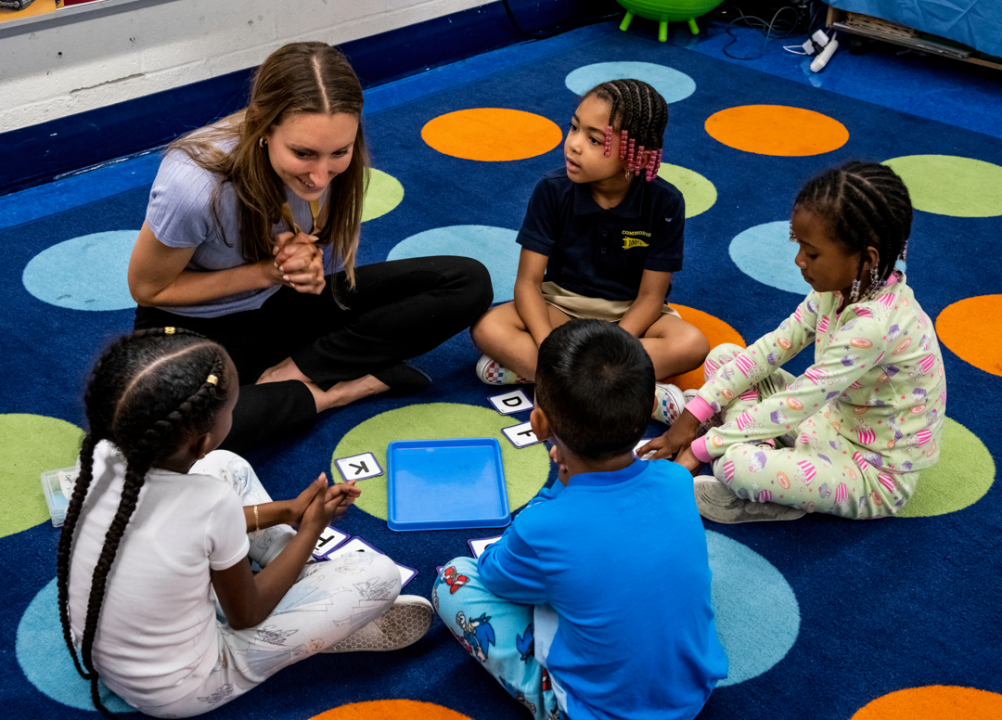
The first few weeks in a classroom can help set the tone for the rest of the school year. Building a sense of safety and belonging for young students early on is critical, said Berol Dewdney, a pre-K teacher and Maryland's 2023 teacher of the year.
Dewdney, who's been teaching pre-K for just over a decade now, said her mother Anna Dewdney, the late author and illustrator of the well-known "Llama Llama" children's books, helped spark her interest in early-childhood education. The Hechinger Report spoke to her about how she creates a welcoming environment for students and about other strategies that help her during the first few weeks of the year.
Consistency helps children know what to expect each day, which also allows them to feel confident and safe in a familiar environment. An example of a classroom routine could be creating a morning ritual with students, like going over the rules at the start of class or giving students a job to do like greeting each other at the door each day, said Dewdney, who teaches at an elementary school in Baltimore.
"The brain is pattern-seeking and survival-oriented, so we create consistent routines at home and at school so that we can help our kids feel safe so they can effectively connect with others and effectively learn," Dewdney said. "Those routines, in addition to helping students feel safe and have a dependable sense of what's going on in their lives, also helps them build executive functions."
Every day, Dewdney tries to have meaningful interactions with her students, sometimes planning those exchanges in advance. One activity she likes is an "I love you ritual," a term coined by Conscious Discipline, a company that provides training on social and emotional learning. The rituals can be about anything, but they always have four components: presence, appropriate touch, eye contact, and a "playful spirit."
One of Dewdney's ideas of an "I love you ritual" with students is a nursery rhyme that involves fingerplay: "Round and round the garden goes the teddy bear, one step, two step, tickle you under there." During this rhyme, Dewdney draws a circle on students' hands before tickling them under the chin or arms.
The game helps build a healthy adult-to-child relationship and it also builds a structure kids can draw on to create similar healthy rituals and interactions with each other, Dewdney said. "Adult-child interactions we know to be one of the most important things in an early childhood classroom," Dewdney said. "Planning for those interactions and making time for those interactions is essential."
Staying calm when a student is misbehaving or when something stressful happens models how to respond to a conflict.
"If we're going to empower kids to be in charge of themselves and to self-regulate and to love and learn and lead effectively, we have to first do so as adults. And it can be really hard — in life, in a classroom, with XYZ going on in the world — to maintain your self-regulation and calm," Dewdney said. "One of the first things that a grown-up and educator can do is really practice the structures that make them feel calm and safe."
Dewdney uses breathing exercises in the classroom as one way to foster a sense of calm. She teaches her students the exercises to help them learn to self-regulate, but she also uses the activities for her own benefit.
All of these activities are ingredients for creating a safe and welcoming environment for young children, she said.
"It feels really obvious to say that it's important that a classroom is a loving space, [and that] it's important that you create a sense of belonging. But what does that actually look like in the classroom? And what are the things that you do as a grown-up to make that happen?" Dewdney said. "That's one of the most empowering things that I've experienced as an educator — that these tools help me feel a connection with kids and families and to really create the loving classrooms that we know our kids deserve."